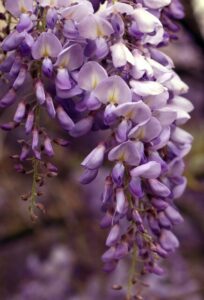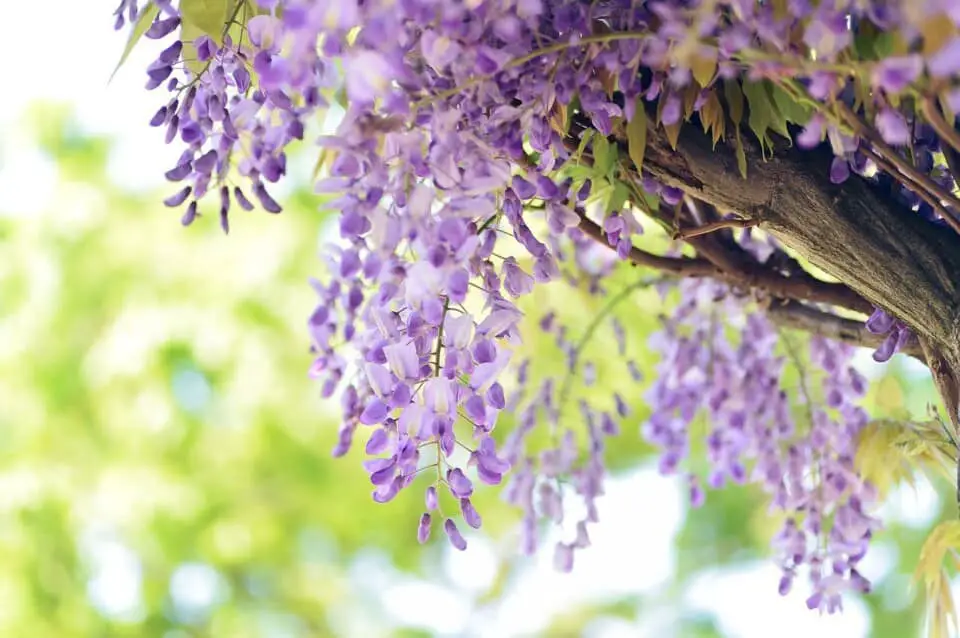Some links in the post are affiliate links and I get a commission from purchases made through some links found in the post.
Have you ever potted a houseplant? If yes, you understand the work that goes into ensuring you get the right selection for your plant.
You want soil that comprises the key nutrients, drains well, and has a nice pH to enable your plant to acclimate fast and grow well. Are you wondering what can work for your wisteria?
You will be happy to know that your wisteria is quite hardy and will do well in almost any soil.
However, it does have some preferences regarding which nutrients should take the forefront and how soggy it likes its soil.
A wisteria needs a medium draining and medium compact soil. The soil will need to be slightly acidic to neutral being between the ranges of 6pH to 7pH.
The wisteria is a nitrogen fixing plant but develops this ability more as it matures so a young wisteria will need a balanced NPK fertilizer.
Once you get these factors out of the way, you will have an easy time making sure your plant does well.
Let’s get into it:
What Soil Nutrients Does a Wisteria Need?
The wisteria is a nitrogen-fixing plant such that it derives nitrogen from the atmosphere. However, this does not happen from the word go.
Instead, the plant develops this self-reliance once it has matured and is ready to bloom. Thus, we will divide the nutrients as follows:
Young Wisterias
 Young plants focus on growing longer and wider. And in wisterias, this stage, referred to as the juvenile stage, can continue for about three to five years in grafted cuttings.
Young plants focus on growing longer and wider. And in wisterias, this stage, referred to as the juvenile stage, can continue for about three to five years in grafted cuttings.
It can take more than five years for plants grown from seeds. At this stage in the wisteria’s life, the plant will focus on developing its shoots and roots. And using a balanced NPK fertilizer would make sense at this point.
The nitrogen would help the plant develop healthy stems, leaves, and branches – while the potassium and phosphorus would come in handy in developing healthy root systems. You can use balanced ratios like 10-10-10 for these plants.
Mature Wisterias
In most cases, mature wisterias do not need supplemental nitrogen as they can get it from the atmosphere.
However, they will still need phosphorus and potassium as these nutrients are essential in the growth of healthy roots and blooming.
A wisteria that does not have such nutrients will often show signs of yellowing and will also exhibit poor blooming.
When feeding a mature plant, do so once in the spring before the blooming starts to give the buds a better chance of flowering.
And use a feed with low or no nitrogen content. Else, the nitrogen will encourage the plant to produce more leaves in lieu of healthy flowers.
Where can you get these essential nutrients (NPK)? Commercial feeds are a great starting point. Or you can rely on compost which you can make using readily available kitchen waste.
The other option would be to get a good potting mix that encompasses these nutrients and has the right pH and drainage rate for your wisteria. I will get into that in more detail later.
Are NPK the only nutrients your wisteria needs? Not quite. Your plant still needs nutrients like zinc and manganese but in smaller amounts.
It can get these from commercial feeds, potting mixes, and even organic implements.
As long as you do not overfeed it with one essential nutrient, the plant will always have access to the micronutrients, which are just as important as the major ones. All it takes is balance, and your plant thrives in no time.
You may also like: 6 great benefits of owning a wisteria
What Type of Soil Should You Use for Your Wisteria?
Figuring out the ideal nutrient mix for wisteria is often easy. The hard part comes about when you need to decide just how light or dense the soil should be and how this impacts your plant. So, what should you look for?
A Medium Texture
Wisterias prefer fluffy soils that are not too light. When soil is dense and compacted, it becomes hard once you water it.
And that reduces the air packets available to the plant’s roots, creating an environment that can harbor fungi that attack the wisteria. Over time, mold or root rot signs start showing as the plant slowly starts dying.
Thus, you should avoid compacted, and clay-like textures as these would only spell disaster for your wisteria. But how can you judge the density of soil?
It’s easy – the soil should look and feel light to the touch, just like loam would. And if you have a hard time deciding on what soil to choose, go with loam. It’s perfect for sun-loving plants like wisterias.
Medium Drainage
Wisterias grow in wet areas and thus prefer to be in moist soil. However, they do not enjoy being in soggy soil.
Soils with high water-retention rates are thus a big no, as they hold on to water for far too long.
And this leads to the drowning of the wisteria roots. Soils with medium textures generally have good drainage and adequate water retention rates.
But it’s always good to check the drainage rate before moving forward with the planting.
Of course, the soil should also be nutrient-rich. And you can always achieve this by adding a commercial feed or compost to the mix. Better yet, you can get soil that checks all the above boxes right from a gardening store!
You may also like: The common problems with a wisteria & how to fix them
What Are the Signs You Are Using the Wrong Soil for Your Wisteria?
Uh-oh! Could your wisteria be signaling that it’s in dire need of a soil change? Generally, wisterias do not like being transplanted and prefer being in the same spot.
After all, their roots are quite extensive, and moving them damages them to some extent.
But in some cases, you have no option but to amend their soil or move them to another location entirely. When should you take heed of these signals?
When your wisteria produces few or no blooms
 A wisteria past the juvenile stage is mature enough to produce healthy blooms. So, if your plant has not started flowering, you have a reason to grow concerned.
A wisteria past the juvenile stage is mature enough to produce healthy blooms. So, if your plant has not started flowering, you have a reason to grow concerned.
You should assess its access to light and whether it gets sufficient water. Does it have access to the full sun at least 6 hours a day?
Does the plant get at least an inch of rainfall each week? If everything checks out, you may want to investigate the type of soil you have used for your wisteria. The soil should be well-draining and fertile.
Moreover, it should contain enough phosphorus and potassium to support healthy blooming. A good way to check if the plant has enough nutrients is to conduct a soil test and know what’s missing.
If the nutrient balance is adequate, the problem likely lies with the drainage. Please note that the nutrients could be on the extreme side in some cases, such that they have damaged the plant’s roots.
When the wisteria has slowed and sickly growth
Wisterias may take a while to mature, but they are fast-growing plants. Studies have even categorized them as invasive species, which are hard to control once they have established.
So, if your wisteria is not growing fast and seems weak, it might not be getting enough nutrients – this is especially true for younger plants that need nitrogen to mature.
If they lack this nutrient, their growth suffers, and they start showing signs of yellowing and may be prone to pest infestations.
When the wisteria appears wilted
Drainage plays a vital role in the health of your wisteria. When the water retention rate is optimal, the soil holds on to what it needs and allows the excess water.
But when it’s too fast, the soil ends up dry almost as soon as you water it. As such, you find that even if you keep watering the plant, it still appears droopy because its cells lose water fast.
Is this the case with your wisteria? Well, the soil does not lie. An easy way to check if the drainage is too fast is to check the state of the soil a day or two after you have watered the plant.
Are there cracks on the soil surface? Does the soil feel almost completely dry barely two days after watering? The drainage rate may be too high, and your plant may not be getting enough water.
When the wisteria appears yellow and droopy
While underwatering is a common issue related to poor soil mixes, overwatering is also something to consider.
If you choose soil with a low drainage rate and fine texture, it holds on to too much water, suffocating the wisteria roots.
Such a plant cannot make enough food, and soon enough, the plant starts losing its hue, and blooming comes to a slow.
Have you noticed such changes in your wisteria? The issue could be your soil.
You may also like: Wisteria vs lilac
What pH Should the Soil Be for A Wisteria?
Alkaline soils make wisterias chlorotic, taking away their ability to make enough chlorophyll. Such plants turn yellow and have fewer leaves and blooms.
To avoid this, you should maintain the pH of the soil at a slightly acidic or neutral level. Keep the range between 6 and 7 to be on the safe side.
If you are unsure of the pH of your soil, you can always test it using a home testing kit which you can get at a gardening store.
Our 5 Recommended Soils for A Wisteria
The kind of soil you use for your wisteria affects how much nutrition it gets, how long it sits in water and the overall growth of the plant.
So, when choosing soil for your wisteria, you must consider if it contains the key minerals, i.e., nitrogen, phosphorus, and potassium.
A mix with such nutrients will indicate NPK on its label. Usually, a balanced NPK formula is a good choice.
But for the wisteria, you should only lean on a balanced formula when feeding young plants in the juvenile stages.
As the plant matures, you will need to move to formulas that rely on phosphorus and potassium as the main nutrients.
1) The Miracle-Gro Potting Mix
Whether you are planting your wisteria indoors or outdoors, you will enjoy how versatile this mix is.
It features a mix of peat moss and perlite for good drainage and fertilizer for good measure.
2) The Espoma Organic Potting Soil
This mix features a 7-2-2 ratio and is great for growing wisterias in their juvenile stages.
Its blend is not attractive to bugs and features only organic ingredients geared at increasing your wisteria’s growth rate.
3) The Michigan Peat Garden Magic Potting Soil
With peat, sand, and perlite in your soil, you can rest assured that root rot will stay at bay.
This potting soil is a great way to kickstart your wisteria-growing journey indoors and outdoors.
4) The Black Gold Organic Potting Soil
This would be a fitting choice if you’re looking for an organic mix with good drainage.
Its silicon compound is great at encouraging the growth of healthy flowers, making your wisteria even more breath-taking.
5) The Foxfarm Ocean Forest Potting Soil
This mix features a slow-release fertilizer that replenishes the soil even after it has broken down.
As such, you can sit back and let the organic ingredients work their magic.
Some of these mixes have pH levels above or below the 6-7 range. However, you can always amend them by adding organic implements and checking the pH again before planting the wisteria.
Do Wisterias Need Ericaceous Compost?
Ericaceous compost boasts a pH between 4 and 5, which is highly acidic. And for wisterias, this would be below the recommended 6-7 range.
It would be best to avoid such compost and instead use it on acid-loving plants.
How To Repot a Wisteria
 You should repot the wisteria in the spring every two years or sooner if it shows signs of being rootbound.
You should repot the wisteria in the spring every two years or sooner if it shows signs of being rootbound.
To do this, you should wiggle the wisteria out of its previous pot and soak its root ball in a bucket of water.
That allows the extra soil to fall off the roots, so you do not move the same dirt to the new pot. Then leave the root ball to dry to avoid drowning the roots.
Choose a pot that is one size bigger than the previous one and fill it with a suitable potting soil to a third of its height.
Then move the wisteria to this pot and cover it with soil, leaving two inches at the top. Water the soil and place the pot in a sunny section where the plant can acclimate to its new home in time for the helm of spring.
You may also like: Wisteria tree vs vine
Final Thoughts
Keeping a wisteria healthy and happy has to be one of the easiest gardening jobs I have ever encountered.
This no-fuss plant will serve you well if you offer it a nutrient-rich, well-draining, and moist soil mix. Add a full day of sun and a regular watering schedule, and the plant will bloom like you would not believe.
Happy Gardening!







